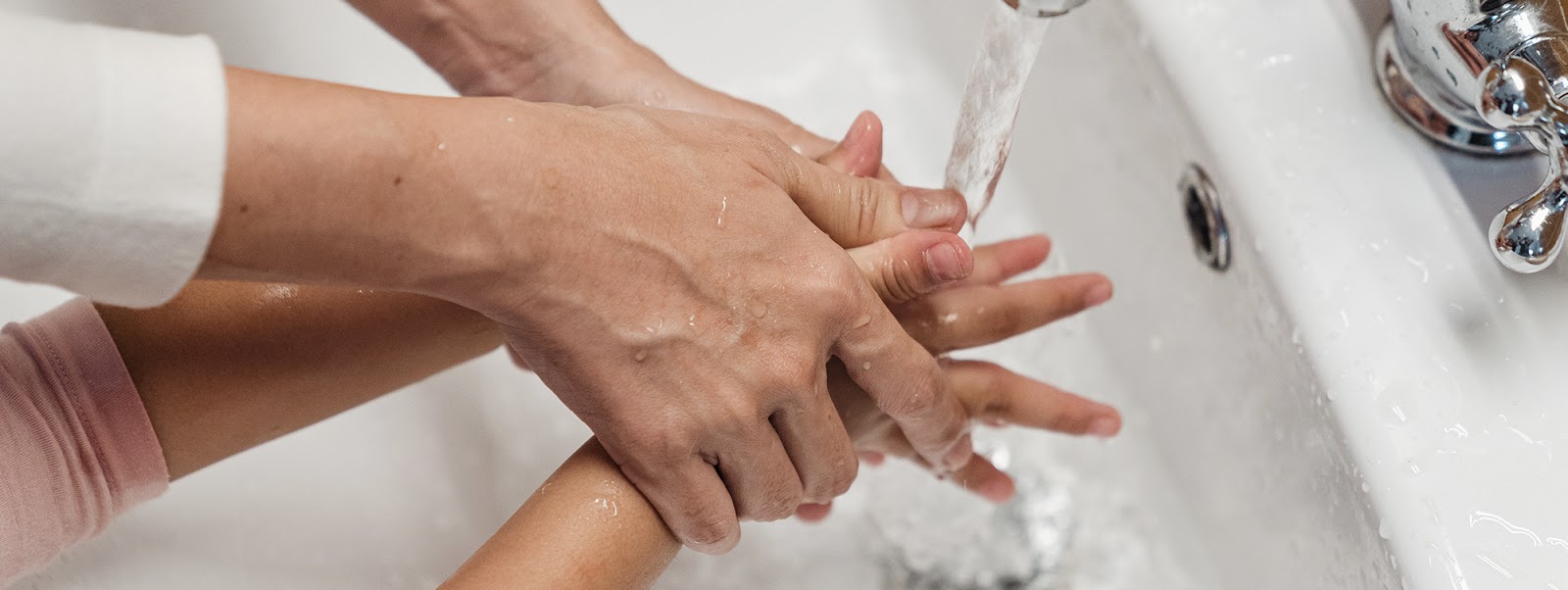Personal hygiene and tidy appearance are important aspects of teaching a blind child to be self-reliant in everyday life. Today we will discuss using a bathtub or a shower cabin at home and in public shower rooms that can be found at school or on campus.
At home, bathroom should be organized so as to be convenient and safe. The child should be given an opportunity to use everything needed for personal hygiene by him/herself. Comfortably place soap, shampoos, shower gels within the child’s reach, so that nothing falls down.
The rules of equipping your bathroom conveniently are simple.
- The child must have his/her own towel. Choose a towel of a suitable size. The material may be different from that the other family members’ towels are made of. The hanger for it should be easily accessed, at a level that is comfortable for the child, so that he/she can reach it and not take another person’s towel instead.
- if the floor in your bathroom is slippery, put rugs on it, and a special rug inside the tub itself to prevent the child’s falling down.
- Buy hygienic products in bottles of different shapes. Shampoo should be easily distinguished from soap, shower gel and other products.
- In bathroom, things always must be kept in order, always in their appropriate places. Ideally, one should reach one’s hand and instantly find the thing one needs in its proper place. Ask the sighted members of the family not to rearrange items.
- If you happen to buy different hygienic products in bottles of the same or easily confused shapes, keep them apart from one another, so that they aren’t mixed up, or label them using rubber bands or 3D stickers.
- Use dispenser bottles for soap and shampoo.
- A toothbrush and toothpaste for the visually challenged child should be kept in an individual cup that, ideally, should be attached to a wall — that way it will always be in its proper place and won’t fall down while the child is trying to find it.
- In case you are not providing an individual cup, try to buy toothbrushes of different shapes, so that the sightless child can tell his/her own toothbrush from the others.
- If the visually challenged child finds using bar soap difficult, buy liquid soap in a dispenser bottle. However, it is essential to train the child to use bar soap as well.
Audio description: a coloured photo. A big white porcelain sink with a shining chromium faucet. A strong torrent of water is pouring out of the tap. The bathroom is decorated with small grey tiles. On both sides of the tap there are two small wooden shelves with soap and a transparent pink bottle. A rectangle mirror is hanging above the sink.
When you go to the bathroom at someone else’s house and find unusual configurations of sinks, taps, flush systems etc. there, be sure to show them to your child. If he/she happens to be alone somewhere, it will be easier for him/her to adapt.
Tell the child about common principles of organizing space in bathrooms. They may be of various sizes and somewhat different in contents, but usually they are quite alike. A bathroom may have no sink in it, it may be a combination bathroom, it may have a shower cabin instead of a bathtub, etc.
Soap is usually placed upon a sink, next to it or on the brink of a bathtub. In order to find soap and tap one should
- smoothly slide the edges of both hands along the edge of the sink and find soap and other items. It is especially important to use this technique while at someone else’s house because you don’t know what lays upon the sink.
- If you simply reach your hands out you may accidentally drop things.
Teach your child to find items unaided, do not pass him/her everything that’s needed, especially if you don’t voice what you are giving the child. “Fewer wonders” — that’s the main rule that parents and teachers should follow. If a child is passively standing in a bathtub, and something is pouring and foaming over his/her head or things emerge out of thin air, the child is getting no training, accumulating no experience.
Step by step try to teach the child to do all hygienic procedures on his/her own. Choose such a haircut for your child that is easily manageable for him/her. It is especially important if he/she lives at school.
If you think that the child cannot wash his/her hair, or take shower, or clip his/her nails, etc. unaided yet, you should think about separate steps each procedure includes, divide each procedure into smaller and simpler actions. At first, teach your child to do simple, manageable actions, then unite them and move to more complicated ones.
For example, in order to wash your hair:
- You turn the water on.
- Adjust its temperature (starting with cold water, checking it by touching the faucet).
- Moisten your hair.
- Find the shampoo.
- Open the shampoo.
- Put down the cap if it is detachable.
- Pour out an adequate amount of shampoo.
- Put the shampoo bottle back.
- Apply the shampoo to your hair.
- Rub it in till it foams.
- Wash away the foam.
- Turn the water off.
- Remember to screw on the cap of the shampoo bottle (no need for that if it is in a dispenser bottle).
- Dry the hair using a towel.
- Comb your hair, set it or use a hair dryer.
At first, the child is able only to find the shampoo or open the lid, etc.
If a girl has long hair, after washing it she should check that no fallen-off hairs are stuck in the drain. She should check this every time. If some hairs are found, she should pick them up and throw them into the garbage.
Make sure to teach your child to put things strictly in order, in a line. Each item must have its proper place. Show your child how to sort dirty and clean clothes. He/she will especially need this skill if he/she is going to live at school.
It is advisable to teach your child to carry out all hygienic procedures unaided before he/she enters the first grade. Discuss with your child which procedures are to be done daily and which are less frequent. For example, one must brush one’s teeth, wash one’s intimate parts and comb one’s hair every day. One may wash one’s hair once in two or three days, but never allow the hair to get greasy. It is important to make the child understand that people around are sure to notice dirty hair, unclean teeth and unpleasant smells.
Shower facilities at school and on campus may cause certain difficulties.
Audio description: a coloured photo. A silhouette of a child in white clothes. The child is holding out a handful of soap bubbles.
Pay special attention to the following:
- Preferably, walk around the sower facilities in advance. You may go there with your parents or a teacher. It is best to choose the time when the shower is less used. Ideally, one should get a permission from school/campus staff to go to shower facilities when there are no people inside. You can make a relief map of the shower room. It is important to check where one can undress, whether there are hangers or lockers for the clothes. Next, find out how one gets from the place where one leaves the clothes to the shower cabin and back. Study the shower cabins and find out where the showerhead is, what kind of faucet is installed there, and most importantly, whether there are shelves or hangers to put one’s towel, shower bag, etc.
- Try to put your things into the outermost locker/onto the outermost hanger, thus it will be easier to find them afterwards. If on one side the outermost one is occupied, check on the other side. If there are no vacant outermost hangers on either side, count the number of the hanger that is free (ideally, the second or the third one). Make sure to remember which hanger you put your clothes on. It is easier to remember the number of the hanger than to examine by touch all the things that hang in a row.
- The shower bag you are taking with you must have a hanging loop and contain everything you need.
- Public shower facilities often have benches. As a rule, they are placed in the center or along the walls of a dressing room. You may check the way from the benches to the hangers if necessary. The drawback of such benches, especially if they are placed in the middle of the locker room, is that if you put a plastic bag or a backpack on them, your things are likely to fall down and the floor is often wet. Buy a comfortable bag with broad stable bottom and stiff flanks so that nothing falls out of it.
- Finding a vacant shower cabin may cause certain difficulties. One can slide one’s hand along the wall, but sometimes sightless people prefer to use a white cane. If you use a cane (as a rule it is needed in shower facilities with many shower cabins), put it in a corner while taking shower.
- To determine whether the cabin is occupied, one can simply listen. If it is quiet inside, most likely the cabin is vacant. Just in case, ask if anyone is in there before entering. A person might have turned the shower off but not left the cabin yet.
- If there are many sighted people in the shower facilities (on campus), you may ask their assistance in finding a vacant cabin.
- If the showerhead is placed up above and cannot be removed from the holder, do not stand beneath the shower while adjusting the water temperature.
- It is advised to put rubber slippers on in public showers.
- If a young girl has started to menstruate recently, it is recommended to discuss with her difficult situations in public showers and help her find the optimum solution. If she uses hygienic pads, she can prepare a special plastic bag to put away underwear and the used pad. If there is a dustbin in the shower, she may throw away the used hygienic products then and there. If it is more convenient for the girl, she can prepare clean underwear and attach a pad to it in advance, so that she can quickly put it on in the locker room. She can bring clean underwear and hygienic pads to the shower cabin, take off the underwear inside the cabin and put the used things into her shower bag.


